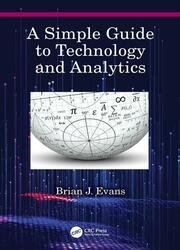A Simple Guide to Technology and Analytics
- Добавил: literator
- Дата: 1-08-2021, 14:05
- Комментариев: 0
 Название: A Simple Guide to Technology and Analytics
Название: A Simple Guide to Technology and AnalyticsАвтор: Brian J. Evans
Издательство: CRC Press
Год: 2022
Страниц: 324
Язык: английский
Формат: pdf (true)
Размер: 18.0 MB
Everyday technology is constantly changing, and it’s hard to keep up with it at times. What is all this talk about automation, STEM, analytics and super-computers, and how will it really affect my daily life at work and in the home?
This book is a simple guide to everyday technology and analytics written in plain language. It starts with explaining how computer networks are increasing in speed so fast that we can do more in less time than ever before. It explains the analytical jargon in plain English and why robotics in the home will be aided by the new technology of the quantum computer.
Richly furnished with over 200 illustrations, photos and with minimal equations, A Simple Guide to Technology and Analytics is a ready reference book for those times when you don’t really understand the technology and analytics being talked about. It explains complicated topics such as automated character recognition in a very simple way, and has simple exercises for the reader to fully understand the technology (with answers at the back). It even has explanations on how home appliances work, which are very useful the next time you go shopping for a microwave or TV. Even the Glossary at the back can be used as a quick look-up explanation for those on the go.
It was explained that in order to analyse sensor data that was being sent to the central control point for recording and analysis, there needed to be software capable of receiving and analysing the data. The computer programming language of choice to perform simple but rapid predictive analysis is called R which was released for public use around 1997 at the University of Auckland (New Zealand) by Ross Ihaka and Robert Gentleman (so R came from their first names). R does most of the basic mathematical manipulations required for data analysis, has good analytical graphics, and its code is used in many smarter languages which provide other software attributes. Sometimes, the simple ability to call up a set of computer lines can make the computations much faster, and, when multiple programs have this capability, they are often referred to as a toolbox. R has many toolboxes and stock sets of lines that can be used to produce publication quality graphics. It is also one of the easiest data analytical computer packages to learn.
Another common analytical language used by industry is Python developed after 2000. It provides a more general approach to analytics and can incorporate much of the R code. It is often used for Machine Learning and can combine the data patterns with predictions for display purposes and go some way towards Artificial Intelligence for future predictions. This software is part of the world of Big Data, which really just means a lot of data flowing to computers.
After reading this book, you will:
• Have a better understanding of the most common smart technologies that use simple physics and analytics.
• Be aware of the changes in data transmission networks that have caused smart devices to go from 3G, to 4G, to 5G, Bluetooth, and wifi and then be able to assess the future transmission technologies as they are developed.
• Appreciate how the frequency spectrum is used in new tools to employ infrared, ultraviolet, laser and potentially haptic technologies.
• Understand how pattern recognition works, which is used for example: to pick-out faces in a crowd, in security services for passport ID checks, in finger-print recognition and in automatically analysing results from surveys that had been previously labour intensive.
• Be able to work out the basics of the science behind predicting future trends, with applications not only in sports but also in industry and the financial sector.
• Become familiar with the physics of over 100 common sensors that are used by industry, and how they are used to automate processes.
• Understand how robots will fit in our future, ranging from a sensible discussion with Siri to physically playing 3D haptic football or cricket with the greatest players of past and present.
• Know what is meant by the STEM buzz words, including Machine Learning, recursive filtering, Artificial Intelligence, Deep learning, and quantum computing
• Be familiar with how a process can be automated, including the parameters of equipment selection and remote operation.
• Have the tools to consider the future of an automated world, possible processes yet to be invented, and how that could affect your daily life.
• Have an immediate reference Index which can be referred to when someone uses a new ‘trendy’ technology word you don’t understand.
• Have access to further reading, mainly from the internet so that an e-book will link with the web site for ease of additional reading when needed.
Скачать A Simple Guide to Technology and Analytics
Внимание
Уважаемый посетитель, Вы зашли на сайт как незарегистрированный пользователь.
Мы рекомендуем Вам зарегистрироваться либо войти на сайт под своим именем.
Уважаемый посетитель, Вы зашли на сайт как незарегистрированный пользователь.
Мы рекомендуем Вам зарегистрироваться либо войти на сайт под своим именем.
Информация
Посетители, находящиеся в группе Гости, не могут оставлять комментарии к данной публикации.
Посетители, находящиеся в группе Гости, не могут оставлять комментарии к данной публикации.
